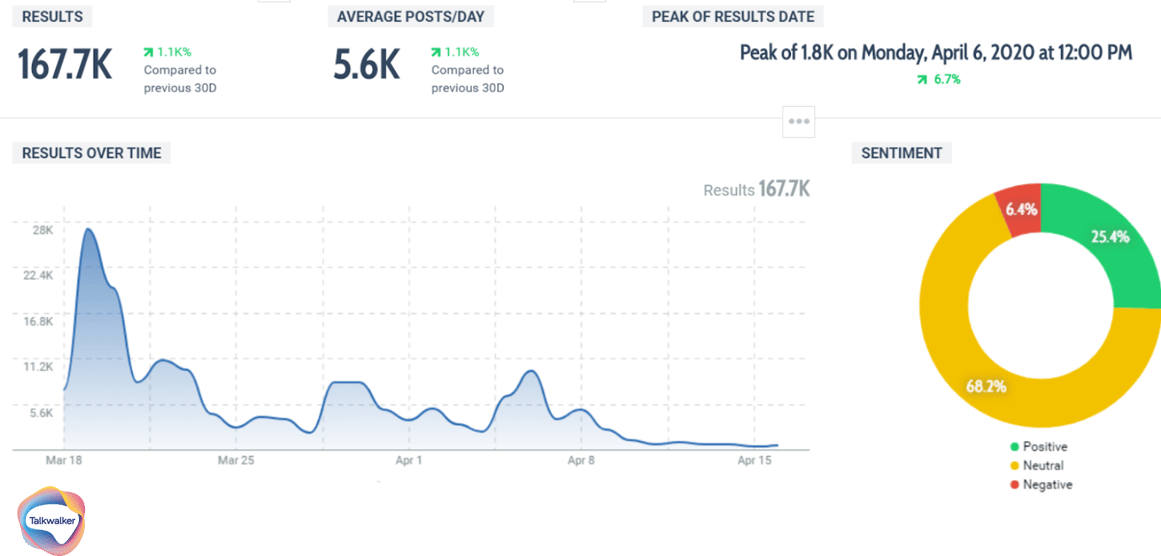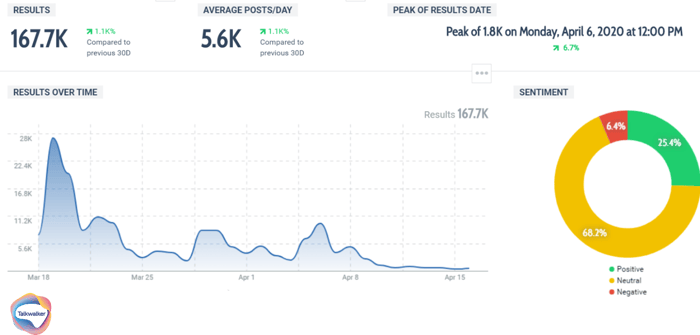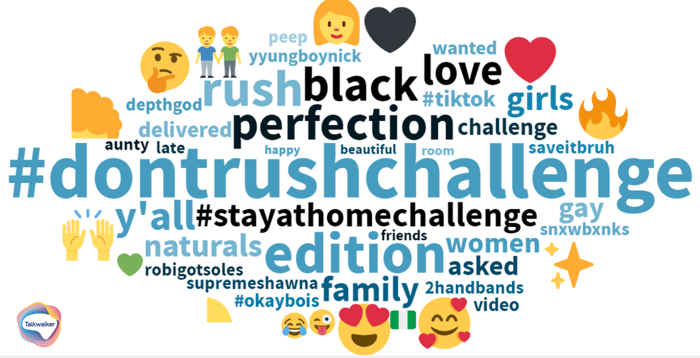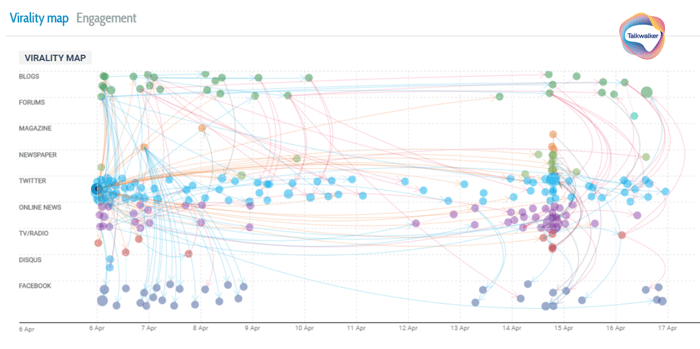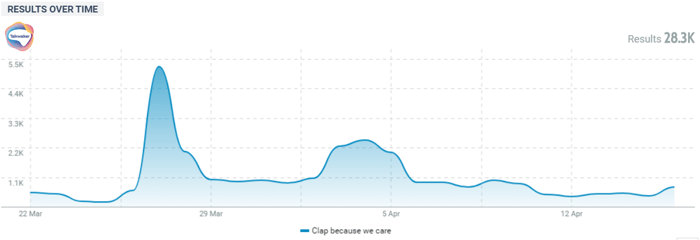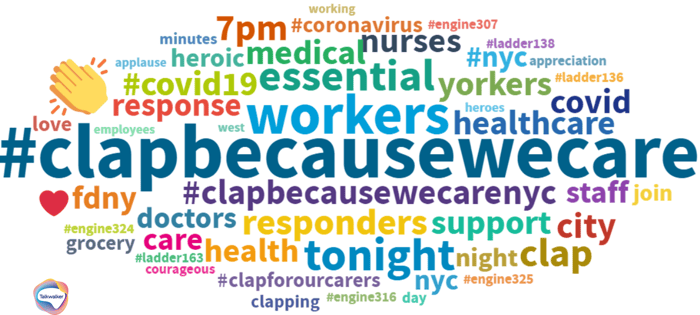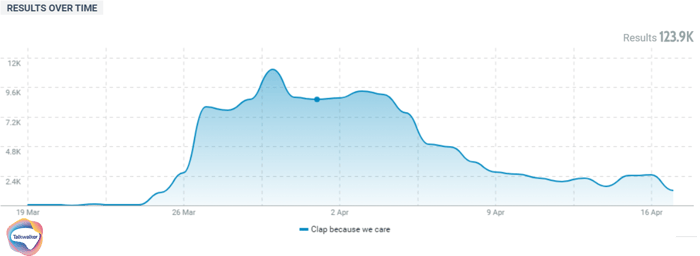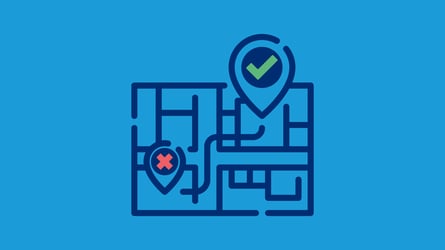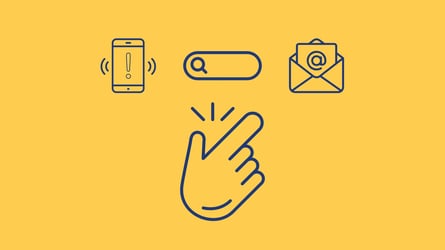Find social trends quick with this free tool
A brand crisis can hit at any moment. Our playbook helps you navigate the storm.
Examined individually, each hashtag sheds light on a specific trend. Examined as a whole, they tell a story of the phases, concerns, and sentiment during the COVID-19 pandemic.
#StayAtHomeChallenge
One of the first hashtags to gain momentum in the wake of the coronavirus was #StayAtHomeChallenge. The trend was started by soccer players who shared videos of themselves juggling rolls of toilet paper during the quarantine. The fancier the footwork and the longer the roll stays in the air, the better.
The one we've all been waiting for
Lionel Messi takes on the #StayAtHomeChallenge
Effortless
Instagram: leomessi pic.twitter.com/9Me24OILuF
— Goal (@goal) March 19, 2020
The Internet loves a good viral challenge and this one was especially well-received. #StayAtHomeChallenge was the perfect outlet for people stuck at home with time on their hands and experiencing withdrawal from live sports.
Between March 16 and April 17, #StayAtHomeChallenge received 167K mentions across social media. Videos by legendary soccer player Lionel Messi, Olympian Usain Bolt, and everyday people partaking in the challenge took social media by storm. The initiative successfully provided distraction and entertainment while most importantly, reminding people to stay home.
#DoNotRushChallenge
Those who prefer sashays over soccer drills, found camaraderie in the #DoNotRushChallenge, which was also shared alongside the hashtag #StayAtHomeChallenge. The challenge is made up of friends who share dramatic makeover videos--think from pajamas to ball gowns - set to the song Don’t Rush by Young T & Bugsey.
View this post on InstagramA post shared by Dr. Lauren Powell (@drlaurenpowell) on
The #DoNotRushChallenge celebrates diverse voices on social media as it gained popularity among influencers and content creators of color. The hashtag was used 401K times on social media between March 16 and April 17. On National Doctors’ Day (March 30), physicians took on the trend by shedding their scrubs and lab coats for glam gowns. The challenge’s feel good vibes, which inspired people to stay home, dress up and connect online, provided a much-needed ray of light for many.
#TogetherAtHome
Music has a way of lifting the spirits and making us feel connected with others. That is the idea behind #TogetherAtHome, a popular hashtag behind the on-going virtual concert series created by the Global Citizen Music Festival and World Health Organization. The goal of #TogetherAtHome is to offer solidarity and entertainment while promoting social distancing.
— Global Citizen (@GlblCtzn) April 6, 2020
The initiative has included at-home performances by John Legend, Shawn Mendes, Camilla Cabello, and others. To date, #TogetherAtHome has received 180K mentions on social media and continues to grow. The series of one-off performances has grown into a fully-fledged One World Together at Home Concert. The historic star-studded event curated by Lady Gaga brought people together, raised awareness for safety, and contributed to pandemic relief funds.
Talkwalker’s Virality map of Global Citizen’s tweet for the #TogetherAtHome concert allows you to see exactly how the tweet spread through different media types.
#FlattenTheCurve
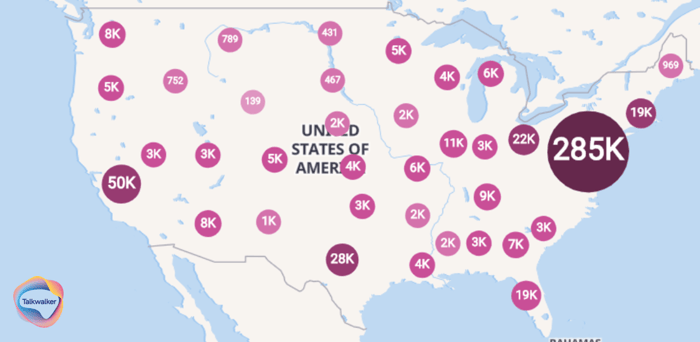
Bosch, the German multinational engineering and technology company, also stands out for its use of #Flattenthecurve on social media. The brand’s global Facebook page shares tips and advice to get through quarantine. Topics covered include decluttering, homeschooling and working from home. A post on how to start a windowsill herb garden garnered 42K likes, more than one hundred comments, and 500 shares.
Concerts and other charitable virtual events are one way celebrities are helping in the recovery from this pandemic, but communicating relatably about the disease is also an important way to raise awareness and get people to take the public health measures in place seriously.
— Kumail Nanjiani (@kumailn) March 22, 2020
Rock your audience with the latest insights from social
Applause for healthcare heroes
Besides sheltering at home the only thing left for many to do, in New York City and across the globe is clap. Applause breaks out nightly at 7pm to thank healthcare workers and others on the front lines. It reminds me, amongst other things, that my kitchen clock is 2 minutes slow.
Turn up the sound! This is what #NewYorkers do now every nite at 7p. Clap & cheer for our courageous Doctors/Nurses/1st Responders. #coronavirus #COVID19 #ClapBecauseWeCare #ClapForOurCarers @EveningEdit https://t.co/3Yo1Ih8Lk0
— Elizabeth MacDonald (@LizMacDonaldFOX) April 4, 2020
At first, we watched similar videos come from Italy, Spain and elsewhere in Europe. Then it started happening here. At first, it could just be mistaken for someone making a lot of noise, quite typical for New York. Then sometime at the end of March (editor's note: the data makes clear it was March 27 or 28) it became a roar, unmistakable in what it was or who it was for.
Mentions of clapping for healthcare and other essential workers - without a hashtag associated with the action, over the previous 30 days.
This is borne out in the data, as we see 28K mentions of general clapping or applause for essential workers in the last month without any associated hashtag.
Theme clouds weigh the frequency of each term - here looking at NYC's response for healthcare workers.
On Friday night, New Yorkers took to their windows to applaud the health care workers, first responders, nurses, grocery store employees, truck drivers & many more who are stepping up to keep us safe during these unprecedented times. Thank you for all you do. #ClapBecauseWeCare pic.twitter.com/sStyFEeuAW
— TODAY (@TODAYshow) March 28, 2020
Eventually a hashtag around these efforts was born: #ClapBecauseWeCare. It has 125K mentions since it really started gaining steam on March 27.
Mentions of #ClapBecauseWeCare displayed over weeks from March 19.
Just plane grateful for the healthcare workers, first responders and everyone else keeping our NYC hometown and everywhere else going right now. #ClapBecauseWeCare pic.twitter.com/oeiIzJ59vv
— JetBlue (@JetBlue) April 2, 2020
#HealthcareHeroes
One way people are showing their appreciation for caregivers is with the hashtag #HealthcareHeroes which has 120K mentions over the last month. Many people are using it to thank healthcare workers, or to share their donations of things like personal protective equipment, critical supplies, and other ways they are supporting healthcare workers.
John Krasinski has the most engaging tweet using the hashtag, though that’s hardly a fair measure as most of the other people using the hashtag don’t have their own TV show.
HUGE thank you to each and every one of our #HealthcareHeroes and to @RedSox and @ATT for making episode 3 of @somegoodnews such a special one! https://t.co/6Xo4opHjpm
— John Krasinski (@johnkrasinski) April 13, 2020
#LightItBlue
One big way for municipalities to get involved in the hashtag game was to have a coordinated show of solidarity. Buildings across the country, from Boston to Los Angeles flooded the skyline in blue lights in support of healthcare workers and the hashtag campaign #LightItBlue.
You can see the beautiful result in pictures of city skylines from across America on April 9.
#LightitBlue in support of America’s #frontline medical workers ... from #Air7HD @ABC7 #abc7eyewitness #losangeles #dtla #covid #coronavirus #pandemic pic.twitter.com/YsQPookyAM
— Chris Cristi (@abc7chriscristi) April 17, 2020
The result on social media, however, was completely different. The hashtag generated nearly 60K mentions, but just on the day of the campaign. Since then it’s practically nonexistent.
Mentions of the hashtag #LightItBlue over the previous month.
Where was all this leading? Well, on April 16 New York broke out in an eponymous song, as attempts were made on Facebook Live to try and singalong to the Frank Sinatra classic “New York, New York”.
As you can see, the results were varied:
New Yorkers cheering for health workers once again and attempting a New York, New York sing along - we are going to need more practice. pic.twitter.com/WLBQwGDGxW
— Juan Manuel Benítez (@JuanMaBenitez) April 16, 2020
However, this happened across the street from me, so I was under the impression everyone was treated to such dulcet tones.
Listen to this golden-throated NYC man sing ‘New York, New York’ during a nightly round of cheering for health care workers pic.twitter.com/VSdnO6tqBI
— NowThis (@nowthisnews) April 17, 2020
Stay for the impassioned “I love you, New York!” at the end.
VIDEO: New Yorkers sing Frank Sinatra's "New York, New York", as an ode to the city's essential workers amid the coronavirus pandemic pic.twitter.com/J60k8vwQoM
— AFP news agency (@AFP) April 17, 2020
It’s how we all feel, and for most, it’s all we can do.
What came flooding back as we sang, was the noise. For a moment New York sounded like it does after a win at Yankee Stadium. It sounded like its old self again.
=============================================================
This PR Crisis eBook has all the steps your brand needs to take to avoid PR disaster, the messaging you craft during the crisis, and how to build a team of trained professionals to help you navigate the storm.

